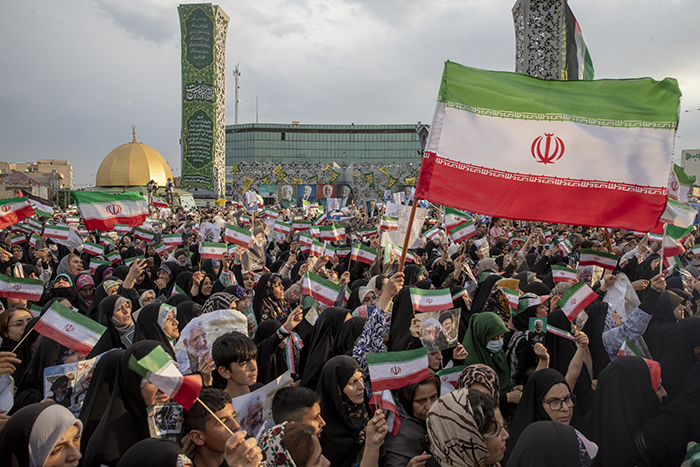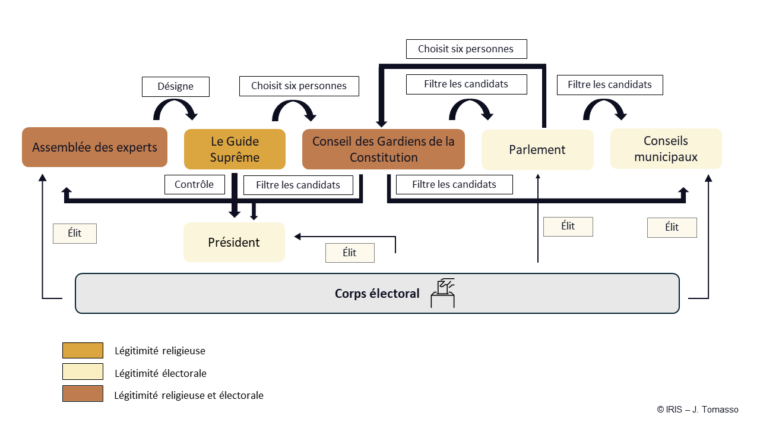Analyses / Middle East / North Africa
26 June 2024
Iranian Presidential Election: Limited Strategic Impact for Iran ?

As the Iranian presidential election of 28 June 2024 approaches, the political landscape is shaped by significant internal challenges. In the background of recent events lie the March 2024 parliamentary elections, widespread economic stagnation, repeated social unrest, and heightened tensions with Israel. The political scene is thus preparing for a crucial electoral contest. Nevertheless, the internal logic of Iran’s institutional framework remains tightly controlled — if not opaque. This article seeks to clarify the hybrid nature of Iran’s electoral functioning, as well as outline the key positions of the six candidates’ programmes. However, it must be emphasised that the impact of the election on the country’s strategic direction remains limited. Decision-making power ultimately lies with Supreme Leader Ali Khamenei, the symbolic figurehead of Iran.
A Presidential Election in a Tense Climate
The Iranian presidential election is scheduled for 28 June 2024. This date was set in accordance with Article 131 of the Iranian Constitution, which stipulates a fifty-day timeframe following the death of a president. Ebrahim Raisi died on 19 May, along with his Foreign Minister Hossein Amir-Abdollahian, in a helicopter crash near the Azerbaijani border. Vice-President Mohammad Mokhber is currently serving as interim president.
The death of Ebrahim Raisi has deeply unsettled Iranian society, against a backdrop of persistent political, economic, security and social instability. The unprecedented abstention rate in the March 2024 parliamentary elections once again placed the ultra-conservatives in control of the Majles (parliament). However, this control is based on fragile popular legitimacy, as evidenced by the low turnout and high number of blank ballots. The economic situation is dire: inflation remains at 40%, unemployment is high (8.6%), and the rial continues to depreciate. The Iranian morality police persist in their increasingly harsh repression of Iranian women, enforcing strict hijab rules. In addition, tensions remain high between Iran and Israel following mutual strikes on each other’s territory in April. While the Iranian regime appears intent on avoiding direct conflict with Tel Aviv — aware of its fragile position amid growing internal tensions — Tehran remains determined to pursue its regional ambitions and to maintain a posture of strategic defiance toward Israel.
Furthermore, France, Germany and the United Kingdom recently issued a joint statement condemning Iran’s moves to expand its nuclear capabilities at the Natanz and Fordow facilities. Thus, the upcoming presidential election takes place in a particularly charged context, marked by increasing uncertainty and critical challenges at both national and international levels.
The Guardian Council: A Hybrid Body at the Heart of a Dual-Headed System
Iran’s institutional framework is complex and is characterised by the coexistence of two sources of authority: one democratic, the other theocratic. The country’s democratic legitimacy derives from popular suffrage, exercised during general elections — including the presidential vote. Theocratic legitimacy, meanwhile, is embodied in the Supreme Leader, who oversees all state institutions, including the Guardian Council.
The Guardian Council comprises twelve members appointed for six-year terms. Six of them — clerics — are appointed directly by the Supreme Leader; the remaining six are selected by members of the Majles. The Council plays a central role in the electoral process: it pre-approves presidential candidates, supervises the elections, and validates or annuls the final results, in accordance with Article 99 of the Constitution. This prerogative grants religious authorities the power to ensure that only candidates aligned with the regime’s Islamic principles are permitted to stand.
The influence of religious power over the candidate selection and validation process thus reveals the dynamics of Iran’s dual-headed system. This interaction between religious institutions and the electoral process highlights the country’s power duality, impacting both democratic functioning and political representation.
The Stakes of the Early Election: Political, Economic and Social Outlooks
Since the 1979 Islamic Revolution, “conservatives” and “reformists” have alternated in power in Iran. For the early election on 28 June, 80 candidates — including four women — submitted applications. Only six were approved by the Guardian Council.
The management of international sanctions is a central theme across all six candidates’ programmes. Alireza Zakani, the ultra-conservative mayor of Tehran, favours “self-sufficiency” and advocates de-dollarisation, asserting that Iran must achieve independence to gain “international respect.” Conservative Mohammad Baqer Qalibaf, Speaker of the Majles and a former member of the Islamic Revolutionary Guard Corps (Pasdaran), supports supports diplomatic efforts to gradually lift sanctions. He argues that the Iran–China relationship offers alternative means of economic development and of mitigating the impact of sanctions.
Economic policy thus emerges as a key pillar of the candidates’ agendas, taking centre stage in their speeches and proposals. Masoud Pezeshkian, a senior parliamentarian and the sole reformist candidate, emphasises internal corruption and the importance of aligning with global financial standards set by the Financial Action Task Force (FATF) to attract foreign investment. Conservative Mostafa Pourmohammadi, a former Justice Minister and the only cleric in the race, claims claims that the 29% interest rates charged by banks are driving inflation in Iran. To better control inflation, Mohammad Baqer Qalibaf calls for greater independence from the Central Bank. He also highlights that contracts signed with international counterparts must yield tangible results, and calls for stronger cooperation with the Shanghai Cooperation Organisation and the BRICS group, of which Iran has been a member since January 2024.
Finally, the status of women status of women and the wearing of the hijab were debated by all candidates. Mohammad Baqer Qalibaf advocates for “gender justice” rather than gender equality, highlighting women’s central role in family life. Masoud Pezeshkian, for his part, opposes any form of coercion in enforcing the hijab. In contrast, Saeed Jalili — former secretary of the Supreme National Security Council and Iran’s chief nuclear negotiator from 2007 to 2013 — criticises Western models and promotes the success of veiled Iranian women as a powerful alternative. Conservative Ghazizadeh Hashemi, head of the Martyrs Foundation since 2021, focuses on discrimination and unequal opportunities rather than the hijab. He calls for reforms to better integrate women into the labour market and combat structural inequalities.
In conclusion, recent Iranian polls polls predict a close contest between conservative Mohammad Baqer Qalibaf, reformist Masoud Pezeshkian, and ultra-conservative Saeed Jalili. However, the overall impact of the presidential election on Iran’s strategic direction will remain marginal. Politically and institutionally, Tehran’s strategic trajectory is unlikely to undergo significant transformation.


